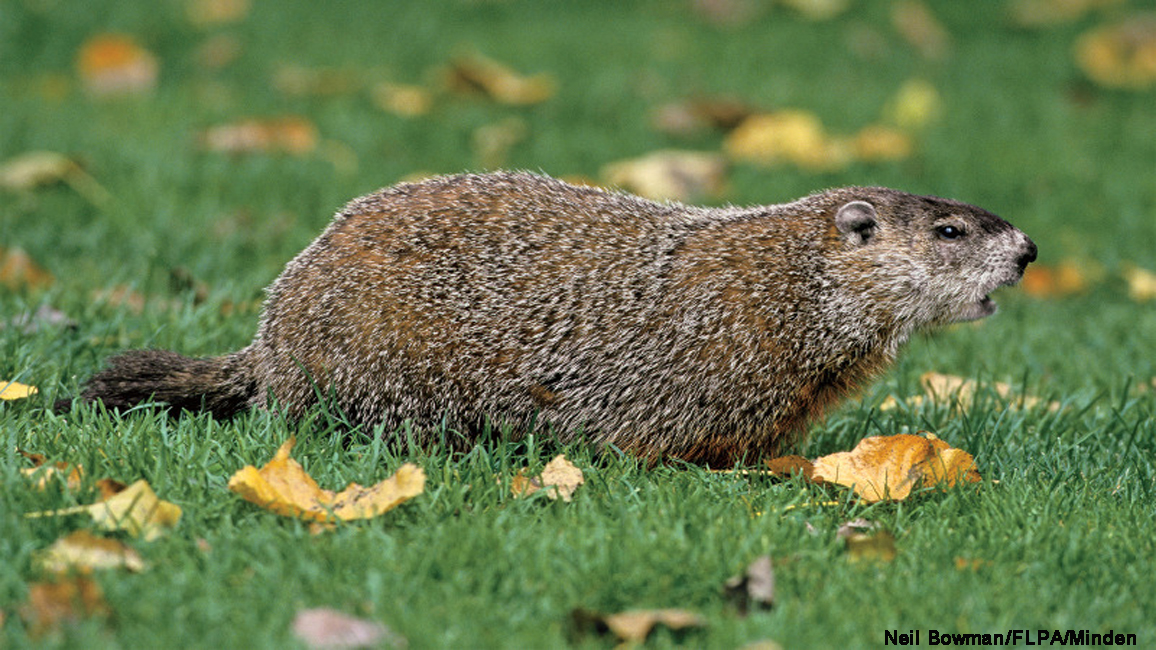
Groundhogs: The Truth Comes Out
By Julia Andrews; art by Dave CleggHey, all you groundhogs out there, rise and shine! It’s February 2—your big day! What? You’re still snoozing? What’s going on here?

You’ve probably heard the story: Groundhogs are supposed to come out of their burrows on Groundhog Day and look for their shadows. If they see them, it means there will be six more weeks of winter. No shadows means spring is near.
But guess what—most groundhogs are fast asleep on February 2. So what about Punxsutawney Phil, that furry guy you may see on TV that day? Phil is really a tame groundhog from a zoo. Wild groundhogs may not wake up for a few more weeks. And when they do leave their burrows, they’re not looking for shadows. They’re looking for mates and food.
Want to find out what groundhogs are really up to all year long? Then keep reading!

WINTER
BEATING THE COLD
Groundhogs (or woodchucks, as lots of people call them) often live where winters can be cold and snowy. The plants that groundhogs need for food are dead or covered up. So groundhogs hibernate underground in a burrow. The burrow also provides great protection from enemies.
HIBERNATION STATION
As winter nears, a groundhog gets its burrow ready for hibernation. It gathers lots of dried plants and makes a thick, soft nest. Then the groundhog curls up for a very long, very deep winter’s sleep.
NEARLY DEAD
When a groundhog hibernates, its body temperature drops as low as 37° F (3° C)—just above freezing. Its heart beats only four or five times a minute, and it breathes only once every four minutes. With its body slowed down, the groundhog can go without food or water for almost five months. (More on that later.)
A FREE MOTEL
While a groundhog is having a long winter snooze, other creatures may sneak into its burrow to find shelter from the cold or to hide from enemies. Mice, chipmunks, squirrels, opossums, skunks, raccoons, toads, lizards, spiders, and other creatures all spend some time—or even all winter—in a groundhog’s burrow.
SUMMER
FAMILY LIFE
Male groundhogs are the first to come out of their dens in the spring. They search nearby burrows for females but usually meet other males. Then they may have a biting fight! Females wake up about three weeks after the males do. Pairs mate, and a month later teeny, hairless pups are born.
Growing groundhog pups like to tussle and play games. Mom sometimes joins the fun. But she also has to keep looking out for foxes and other predators. If she sees one, she whistles a shrill alarm call. That tells the pups, “Dive into the burrow, NOW!”
PIG OUT
Even during the summer, a groundhog spends most of its time inside its burrow. But when it’s outside, it eats like a little pig. It scarfs down at least a pound of greens a day. By summer’s end, the groundhog has doubled its weight.
PIG IN A BLANKET
Pigging out is a matter of life or death for a groundhog. Like a car that burns gasoline to keep going, a groundhog’s body burns fat to stay alive while hibernating. The fat also acts as a blanket that keeps in the animal’s body heat. A skinny groundhog wouldn’t survive a long winter.

NAME GAME
You can probably guess how such a fat creature came to be called a groundhog. But groundhogs aren’t little pigs—they’re rodents, like mice, rats, beavers, and squirrels. Their closest rodent cousins are marmots, which are found in the western U.S., in Europe, and in Asia.
American Indians called groundhogs a name that sounded like “wuchak,” which means “digger.” European settlers thought they were saying “woodchuck.”
WOODCHUCK CHUCKING
So how much wood would a woodchuck chuck, if a woodchuck could chuck wood? No one knows. But we do know that a groundhog chucks soil, and plenty of it. A full-grown groundhog can dig a 12-foot burrow in only a few hours. When building a full-size burrow, a groundhog may clear out 700 pounds of soil!
SO, WHAT ABOUT GROUNDHOG DAY?
It all started in Europe, hundreds of years ago. February 2 was a holiday called Candlemas, when people prayed for mild weather for the rest of the winter. The people believed that, if a hibernating badger woke up and saw its shadow on Candlemas, there would be six more weeks of bad weather.
European settlers didn’t find any badgers when they first settled in America, so groundhogs became the new winter weather forecasters.
Happy Groundhog Day!
Download a pdf of “Groundhogs: The Truth Comes Out.”
















